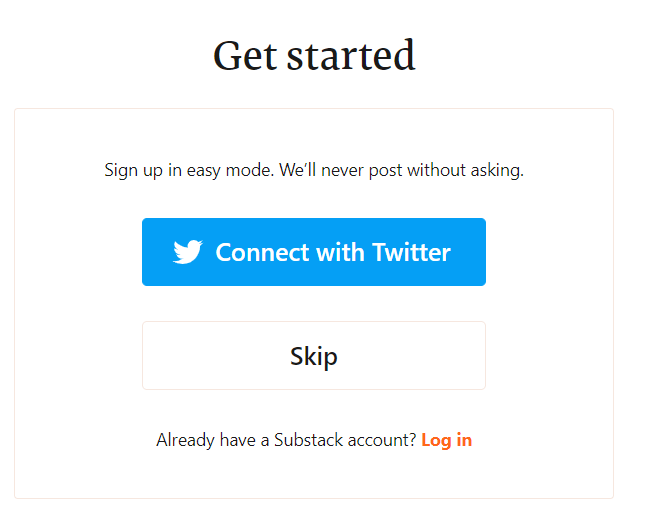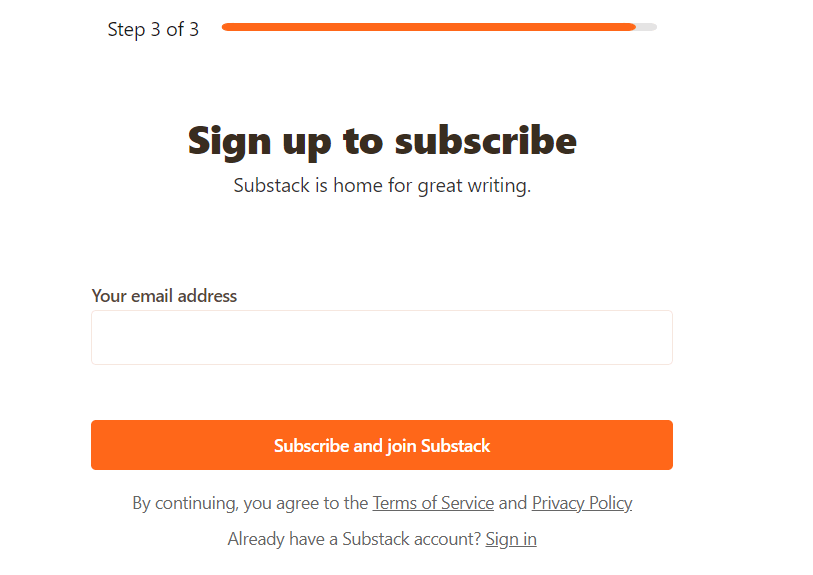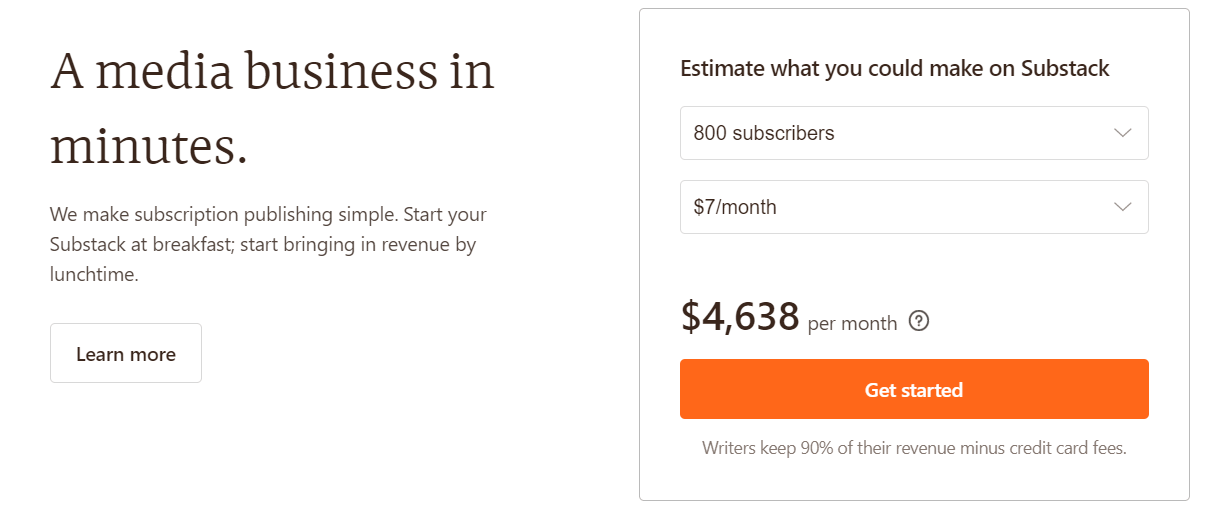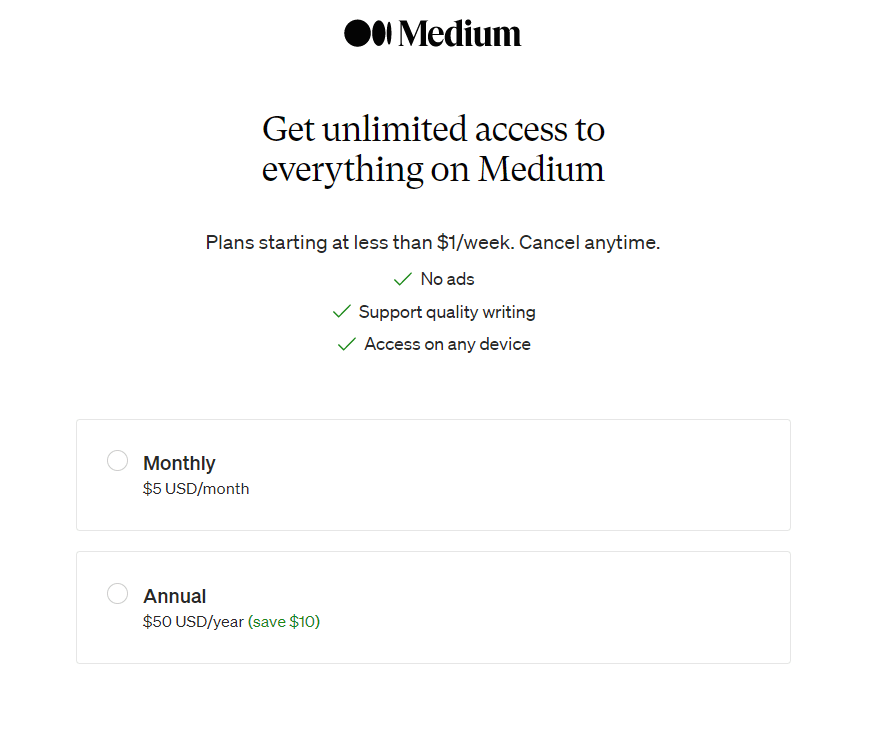What TrustRadius Research Says
Substack Pricing 2022
Writers and content creators need an outlet to build their brand but need an option that offers control. On Substack, you can build a base of newsletter subscribers that pay for your team's original content. Startups will have the power to set those prices and plan for future marketing campaigns. It’s a great opportunity to grow your online presence.
What is Substack?
Substack.com is a virtual writing platform designed for charging subscriptions for access to private newsletters. Creatives of all kinds can use Substack to build their brand and hone their writing skills.
Substack welcomes all types of mediums on its platform. You can do entertainment subscriptions for podcasts, comics, blogs, and food blogging. Professionals can also create newsletters for business, science, investment, and local news articles. Other popular topics include sports, politics, culture, and faith. Whether you write nonfiction or fiction, you can create a consumer base on the site.
Writers can set their monthly cost at any dollar amount they choose for any of Substack’s paid subscriptions. This is designed to simplify publishing as much as possible users have everything they need to turn an existing audience into paid subscribers.
Prospective writers can create a Substack account or use their Twitter account to get started.

Readers will need to select their interests first and are then prompted to sign up with their preferred email address. This is the email they would be using for their Substack newsletter.

Substack seems like an awesome, super easy to use platform for content creators. Is that really the case? We talk about the work that can go into Substack next.
Substack Writing Tips
The biggest selling point Substack makes is for writers to set the cost for newsletter subscribers, and then enjoy monthly income from the subscriber base. They even offer a calculator on the landing page so you can estimate how much you could make.

This simplicity can be misleading. While technically true, Substack recommends you have a substantial free subscriber list before considering monetizing your newsletter. This is very different from their landing page which claims new writers could be making revenue by lunch if they made an account at breakfast. It is an ad after all, so it's going to make exciting claims.
That is why we’re going to talk about the work and effort that needs to be put in before you get paying subscribers.
First things first, you need to take your time building a free consumer base. Substack offers an article about the power of free posts and how you shouldn’t save the best ones for the paid newsletter.
If you aren’t putting some of your best content out there for new subscribers then they won’t be able to see why you are worth their time and money. You can read more about the article here. The article is from the On Substack page, run by the Substack team.
Substack YouTube channel also has a video detailing at what point should you add a paywall to your newsletter platform. The video explains the specific metrics you need to track and analyze. Writers are advised to pay attention to email open rates for new posts, and from there they can estimate the future conversion rate. You can find the channel for the Substack Grow video series here.
Substack Grow: When to consider going paid
Substack also has a written guide for writers to use when creating paid subscriber email lists. It talks about setting goals, creating community, formatting options, and even design elements for branding. You can find the guide here.
You shouldn’t only listen to Substack resources. There are some really helpful videos on YouTube about using Substack.
First, we suggest watching a full-length beginner tutorial that goes over how to navigate the UI and create new posts. Not all writers are tech wizards so the tutorial will be a good idea for getting familiar with the platform.
Substack Tutorial For Beginners 2021 - How To Use Substack For Newsletter
Next is a fiction writer who goes into detail about how they use the Substack platform and how monetizing has worked for them.
Substack for writers: How to get paid for writing
This third video is actually a podcast where the founder of Substack Chris Best talks about the platform and why it succeeded. Other noted founders include Hamish Mckenzie.
Substack Founder on How to Monetize Your Ideas @Chris Best | The Quest Pod with Justin Kan
Another very important tip to know for writing is search engine optimization (SEO). Substack may be its own platform, but it’s still important to do keyword research and ensure the content in your newsletters can rank and be visible to relevant search queries.
With Substack, you even have the option to set up a custom domain. It will also be vital for optimizing the SEO for your landing page. For some help on how to improve SEO, see the article here. If you want to learn about software that can maximize your SEO see the article here.
Finally, if you are an avid learner or a writing team that aims to always improve, consider adding some popular writing guides to your bookshelf.
We recommend Stephen King’s On Writing, which is essentially an autobiography about life experiences, rejections, and the self-doubt he overcame (thanks to his wife). We also recommend the famous grammar guide The Elements of Style from the authors William Strunk (Cornell professor) and E.B. White (created Stuart Little, Charlotte’s Web, and more).
It’s clear that earning an income on the platform may not be easy, but there’s more to consider. How does Substack make money? We go into detail about the types of fees next.
How Does Substack Pricing Work?
There are three main parts to the costs of using Substack. There are the fees the subscribers pay the writer, and there are the Substack and Stripe transaction fees.
When you set up the cost for email newsletters you need to know that Substack takes 10% of your revenue. On top of that, there are credit card fees from Substack’s payment processor Stripe. Stripe charges you monthly fees of 2.9% of your billing rate and 30 cents per transaction.
These fees are small; they're certainly not trying to bleed content creators dry, but you should consider them when setting up the monthly cost. If you want to learn more about calculating fees see this article here.
What Are Some Substack Alternatives?
One of the first platforms that may come to mind is Medium. Medium is another blogging platform where writers can publish their work for free and where readers pay to use the platform. The similarities between the two websites end there.
Medium has a much more complicated pricing structure. Free readers can read up to 3 articles a month and if they want to read more they need a paid membership. The membership costs $5 monthly and $50 annually.

Writers are paid in a less simple way. The only way writers can make money is through referrals, when someone signs up because of an article, and through the Medium Partner Program.
In terms of monitoring referrals, the last article someone reads before buying a paid membership is considered the reason and the writer gets the referral which is half of the membership fee. The writer continues receiving part of that fee for as long as that reader is a member. You can find out more about referrals here.
If you think this can be an unfair way to track referrals, it is. Say you read some articles, and the last one you read gets the referral but you are actually an avid reader of another author entirely. That author will not make money unless they join the Partner Program.
The Partner Program is also a little tricky. Authors receive a percentage of membership fees that correlates with how much the readership actually spends on their articles. If someone spend 20% of their time reading your stuff on Medium then you get 20% of that membership fee for that month. Read more about the Partner Program here.
Unless most of your earnings are from referrals, it can fluctuate. Medium is pretty upfront about the fact that although some writers have made quite a bit of money, most make less than $100. You can learn more about earning on Medium here.
In comparison with Substack, earning on Medium is more frustrating and complex. With Substack you can create a paid email list for subscribers, and they then pay monthly subscriptions directly to you. In Medium you don’t get direct subscribers, and it if you get lucky with a referral
It’s important to note though that if you join the Medium Partner Program, you get paid when someone reads no matter what. On Substack the free content is free content so no getting paid there.
Substack also has the benefit of you being able to choose subscription costs, and if its an attractive enough amount it goes straight to you after fees. With Medium you only get a portion based on how much time people spend reading, or the luck of getting a referral. This means with Substack you can predict earnings while with Medium you cannot.
The best part about these two platforms is that if you can’t choose, you don’t have to. It’s free to publish on both sites. You can experiment with content on both platforms. You should know that even though Medium does allow reccoridngs and web page cusotmizations, it’s not diverse enough with fiction, art, and comics. The majority of content on Medium is nonfiction so be sure to think about that when considering both platforms.
More Resources
If you are interested in looking for more publishing platforms for you and your team we have a list of blogging sites here.
For those that have used any of the platforms discussed here please leave a review to help other buyers make informed decisions.
